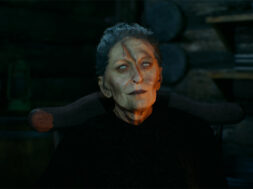‘The Witch Who Came from the Sea’: GLOW’s Sam Sylvia is Based on a Real Director Who Made a Real Horror Movie
In Netflix’s “GLOW,“ which just premiered its second season at the tail end of June, Marc Maron plays the character Sam Sylvia, an ornery but good-hearted filmmaker who directs the women’s wrestling show “GLOW,” the show within the show. Of course, the Netflix series is loosely based on an actual women’s wrestling show from the late ’80s that was titled “GLOW: Gorgeous Ladies of Wrestling,” which means there is *some* truth to Netflix’s “GLOW.”
At the very least, the fictional world created by Netflix has a moderate basis in reality, and that extends to Maron’s aforementioned character, Sam Sylvia. In the show, Sylvia is presented as something of a failed filmmaker who directed a few low-budget horror films prior to entering the world of women’s wrestling, including A Wolf Knocks Once, Blood Disco and Gina the Machina; the last one is briefly glimpsed in the second season of “GLOW,” when Sylvia attends a revival screening of the exploitation horror film he directed years prior.
“I made it when I was younger,” Sylvia tells the small crowd when pressed to provide an intro to the movie. “I think there’s some good stuff in it. I don’t fucking remember.”

Of course, Gina the Machina and the other films Sam Sylvia directed in the world of “GLOW” don’t exist in our real world, nor does Sylvia, but the character was at least loosely inspired by Italian-American filmmaker Matt Cimber, who was indeed the original director of the real “GLOW: Gorgeous Ladies of Wrestling.” According to IMDb, Cimber was with the show from the beginning and straight into 1987, credited as the director of 56 total episodes.
So, did Matt Cimber ever actually direct a horror film, like his fictional counterpart? Yes, he did. Cimber may be most known for his mid-’70s blaxploitation films The Black 6, Lady Cocoa and The Candy Tangerine Man, which have over the years been praised by both Samuel L. Jackson and Quentin Tarantino, but he made his first and only stop in the horror genre in 1976, with The Witch Who Came from the Sea. Notably, the ’76 shocker was one of 72 genre films that the UK’s Department of Public Prosecutions notoriously dubbed a “Video Nasty.”

Matt Cimber and then-wife Jayne Mansfield
Looking at the lurid poster art for The Witch Who Came from the Sea, it would seem clear why it ended up on the so-called Video Nasties list, as it depicted a big-breasted, barely dressed woman triumphantly holding up a severed head in one hand and a bloody scythe in the other; the film’s poster art was “inspired” by a Frank Frazetta-drawn Vampirella comic book cover from the early ’70s, if the word “inspired” can even be used for such blatant thievery.
In any event, like many retro horror films, the attention grabbing poster art for The Witch Who Came from the Sea was highly deceptive, as was its inclusion in the Video Nasties list. In reality, Cimber’s sole horror film is hardly a gory affair so much as it is a psychological one, with its dark subject matter (combined with ample nudity) likely being the reason for its inclusion.
The Witch Who Came from the Sea centers on Molly, played by actress Millie Perkins; oddly enough, the young Perkins is a dead ringer for Alison Brie, the star of Netflix’s “GLOW.” The film documents Molly’s descent into madness, fueled by her deeply traumatizing molestation at the hands of her father as a child and culminating in a brutal series of sexually-charged murders. Molly, a waitress at the local seaside bar, is the “witch” referred to in the title, though she never picks up a scythe, cuts off anyone’s head or wraps a snake around her arm.
Hell, she’s not even a witch!

Rather than playing out like a slasher film, The Witch Who Came from the Sea more closely resembles an exploitation-style character study, using Molly’s trauma-turned-terror to delve into subject matter such as sexual harassment, child molestation and, rather surprisingly, the idolization of television stars. Molly is obsessed with television, and the majority of her (always male) victims, including two football players and the star of a shaving commercial, are almost literally hand-picked from the boob tube. The men seem perfect to her (after all, don’t all celebrities, when observed solely on a surface level?), but things always go haywire when they either turn out not to be or Molly’s tortured mind simply gets the best of her.
In the end, she always ends up covered in their blood.

A film focused on the struggles of a woman irreparably wronged through no fault of her own, The Witch Who Came from the Sea is a surprisingly potent watch today, its confrontational and at times incredibly hard to stomach storytelling essentially belied by its provocative cover art and “Video Nasties” infamy. No, it’s not at all the movie that the original poster art promised. Rather, it’s a deep, dark foray into a world where one woman, against even her own best wishes, has had enough of sleazy men and simply isn’t going to take it anymore.
Oh and did I mention Dean Cundey shot the film? Yes, *that* Dean Cundey!
The Witch Who Came from the Sea is no doubt an oddball gem, but a gem all the same. If you’re interested in checking it out, it’s available for streaming through Amazon Prime.










